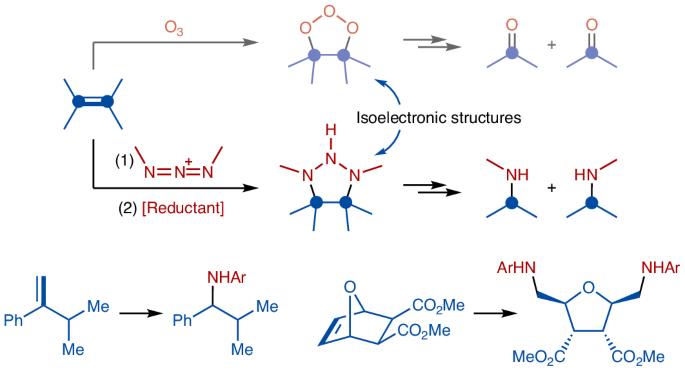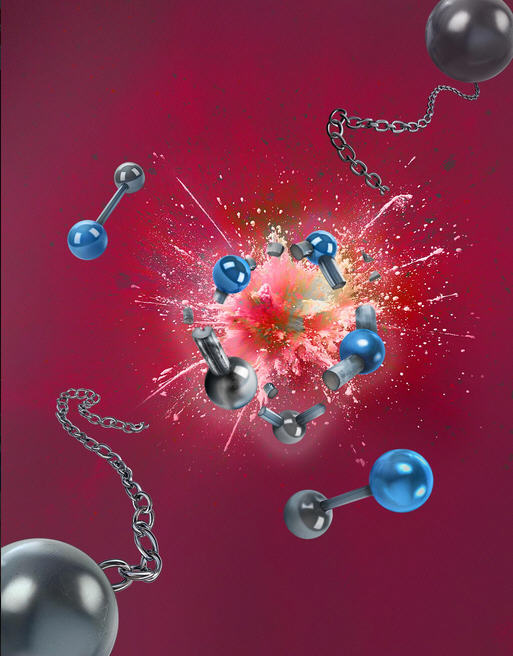博文
这一化学突破可能会改变从医学到农业的一切
 精选
精选
||
这一化学突破可能会改变从医学到农业的一切
诸平
Triazenolysis: making amines by breaking olefins. Credit: Tatyana Savin
据以色列理工学院(Technion-Israel Institute of Technology)2024年11月20日提供的消息,这一化学突破可能会改变从医学到农业的一切(This Chemistry Breakthrough Might Change Everything From Medicine to Farming)。
科学家们引入了叠氮解(triazenolysis,N3),这是一种突破性的化学过程,可以将烯烃转化为多功能胺类物质。
这些胺类物质在聚合物、制药和农业生产中具有潜在的用途。与已有百年历史的臭氧分解(ozonolysis, O3)形成碳-氧键(C=O)不同,叠氮解有效地产生关键的碳-氮键(C—N),增强了其在各种科学和工业领域的效用。
创新化学工艺揭晓(Innovative Chemical Process Unveiled)
以色列理工学院舒利希化学系(Schulich Faculty of Chemistry at the Technion)的研究人员公布了一种创新的化学工艺,用于生产聚合物、药品和农用化合物的原材料。相关研究结果于2024年10月11日已经在《自然化学》(Nature Chemistry)杂志网站发表——Aleksandr Koronatov, Pavel Sakharov, Deepak Ranolia, Alexander Kaushansky, Natalia Fridman, Mark Gandelman. Triazenolysis of alkenes as an aza version of ozonolysis. Nature Chemistry, 2024. DOI: 10.1038/s41557-024-01653-3. Published: 11 October 2024. https://www.nature.com/articles/s41557-024-01653-3.此研究概述了这种方法的发展,并得到了一项计算分析的支持,该分析揭示了其机制和关键阶段。
在马克·甘戴尔曼(Mark Gandelman)教授的指导下,研究团队包括博士生亚历山大·科罗娜托夫(Alexander Koronatov)和迪帕克·拉诺利亚(Deepak Ranolia,以及博士后帕维尔·萨哈罗夫(Pavel Sakharov)。
这个突破性的过程,被称为叠氮解,将广泛存在的烯烃有机化合物,如石油衍生的烯烃转化为多功能胺类化合物。这些胺在工业和研究环境中都有不同的应用,使该过程成为现代化学的重大进步。
桥接碳氮键(Bridging Carbon and Nitrogen Bonds)
以色列理工学院开发的过程模拟臭氧解(ozonolysis),这是一种长期建立的技术,用于产生具有碳-氧键的分子。臭氧解是在一个多世纪前发明的,它能有效地形成碳-氧键,但不能产生碳-氮键。这就是叠氮解发挥作用的地方,通过裂解烯烃中的碳-碳键(C=C),产生与广泛应用相关的碳-氮键(C—N)。参看下面摘要(Abstract)图示。
此研究得到了以色列科学基金会(Israel Science Foundation简称ISF)的资助(ISF personal grant 2023/27 and ISF-NSFC grant 3673/21)。
上述介绍,仅供参考。欲了解更多信息,敬请注意浏览原文或者相关报道。
Alkenes are broadly used in synthetic applications, thanks to their abundance and versatility. Ozonolysis is one of the most canonical transformations that converts alkenes into molecules bearing carbon–oxygen motifs via C=C bond cleavage. Despite its extensive use in both industrial and laboratory settings, the aza version—cleavage of alkenes to form carbon–nitrogen bonds—remains elusive. Here we report the conversion of alkenes into valuable amines via complete C=C bond disconnection. This process, which we have termed ‘triazenolysis’, is initiated by a (3 + 2) cycloaddition of triazadienium cation to an alkene. The triazolinium salt formed accepts hydride from borohydride anion and spontaneously decomposes to create new C–N motifs upon further reduction. The developed reaction is applicable to a broad range of cyclic alkenes to produce diamines, while various acyclic C=C bonds may be broken to generate two separate amine units. Computational analysis provides insights into the mechanism, including identification of the key step and elucidating the significance of Lewis acid catalysis.

https://blog.sciencenet.cn/blog-212210-1461340.html
上一篇:自然疗法可以逆转阿尔茨海默病的症状
下一篇:有关研究表明阿司匹林和其他常用药物可能会增加患痴呆症的风险
